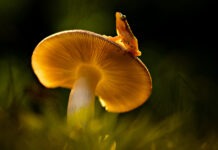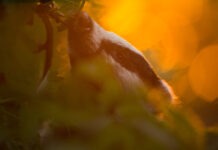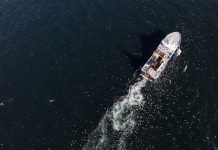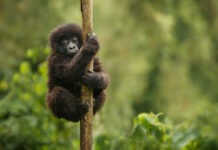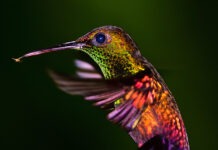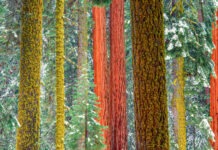In celebration of Australia day we invited outback survival expert Bob Cooper, to list the top five, most likely to encounter, deadly Aussies.
Bob Cooper’s Deadly Downunder Survival Guide
Let’s Start with Spiders…
The vast majority of our 2500 species of spiders in this continent are shy and considered harmless. Only a few will bite when provoked or when feel threatened will cause us concern. Australia has only two of those that are considered to be highly dangerous to humans. These are the Sydney Funnel-Web, the most dangerous spider in Australia and the Red-back spider. Both have a potentially fatal bite. I would also include the Mouse Spider species. They exist across the mainland and Tasmania and are often mistaken for a Funnel Web spider. Treat a bite from these or any other large black spider as you would a Funnel Web bite.
Funnel-Web Spider (Belong to the family Hexathelidae)

The larger females can be 6-7cms long, with the slightly smaller males having five times more potent venom. Both are black in colour and possess large fangs powerful enough to penetrate through your fingernail! This spider is mostly found near Sydney with related species found along the eastern coast and have been reported as far north as Brisbane. Again treat any large black spider bite as potentially life threatening.
Treatment: Pressure and immobilisation bandages must be applied immediately to prevent the possible onset of the reaction in the victim’s system. Transport the victim immediately to the nearest medical facility, preferably a hospital, or phone for an ambulance via the emergency number 000 within Australia. Just like with snake bites in Australia, once the pressure and immobilisation bandages have been applied there have been no reported deaths. Make sure you have three elastic bandages in your first aid kit.
Stonefish (Synanceiidae)
The Stonefish is found in the northern half of Australia. It is the deadliest of our venomous fishes, having been responsible for a considerable number of fatalities. Although commonly known as the Estuarine Stonefish, it is also found in exposed rock pools, far from estuaries. Slight pressure on any of the 13 dorsal spines causes the contents of the venom glands to be expelled under pressure through the hypodermic spine’s tip. By this means a Stonefish can inject the entire contents of venom into your foot or hand at just the slightest touch. The more spines, the more severe the pain.
Recognition: The Stonefish grows to 60 centimetres, usual length 20 -30 cms, and is a sluggish fish. The most common cause of envenomation is by an innocent fossicker treading on one.
Estuarine Stonefish

Precautions: Never attempt to pick one up by hand. Often dead ones are found in the high tide weed line and are still potentially deadly. When walking in shallows, wear stout soled footwear. Tread in sandy spots and shuffle your feet. If you catch one on a line – with much caution cut line off at least 30cms above the fish. The hook will rust out.
Signs and Symptoms: Instant, excruciating pain, spreading along the limb and shock.
Treatment: Get the person out of the water. Get ready to treat for shock. Immerse the limb in hot/warm water. Heat applied can alleviate the pain to a tolerable level. Use any available hot liquid, coffee/tea or soup poured onto a cloth held on the site. Place stones or metal objects on the manifold of your car/boat engine to heat while you are taking the person to a medical centre. When the object is hot, wrap in cloth and apply to the wound area. Immediate transfer to medical centre/hospital is a must.
Puffer Fish, Porcupine Fish and its relative the Box Fish (Tetraodontidae)

All of these fish have a deadly poison called tetrodotoxin abbreviated as TTX. Consider the whole fish and its organs and skin deadly poisonous. It has around 120 different species worldwide and is the second most poisonous creature on earth after the ‘Golden Poison’ frog. In addition, all of the puffer fish have strong parrot-like teeth. Those of the Silver Puffer fish (North-west Blowfish) are very strong, and a bite can remove large chunks of flesh and probably finger tips. There are species of Puffer fish found all around our Australian coastline.
Recognition: Puffer Fish are capable of blowing themselves up like a ball .They have slimy skin and do not look like normal ‘edible’ fish, and they are not! At least four people have died in Australia from eating Puffer fish flesh.
Porcupine Fish have large spiky spine covered bodies and will also puff up like a ball in defence. They are extremely poisonous to eat. Box Fish are also toxic. They are encased in plate like scales forming a bony armoured skin.
Precautions: Do not eat any part of these fish. Take care when removing Puffer fish from fishhooks, their spines cause painful wounds and the larger ones can bite off chunks of your flesh. Wash hands after handling as some toxins can be excreted through the skin of these fish.
Signs and Symptoms: Muscular paralysis, possibly leading to respiratory failure. These symptoms can set in within three minutes of eating the flesh of these fish. Numbness of tongue and tingling of the lips, vomiting, general weakness, tightening of the chest, dizziness and collapse.
Case Study: a 23-year-old man ate a piece of “fugu” – the prepared Japanese style Puffer fish fillet. He consumed a small piece about the size of a ten cent coin. Approximately 10-15 minutes later, he had a tingling sensation in his mouth and lips, followed by dizziness, headache, a constricting feeling in his throat, difficulty in speaking, tightness of chest, physical shaking and vomiting. He weakened and collapsed – hospitalised and lived
Case 2: 32 year-old man ate three bites of fugu over 2-3 minutes. While eating his third bite, he noticed tingling in his tongue, anxiety and “thoughts of dying.” He then felt very weak and collapsed – hospitalised and survived. Hopefully that’s enough to put you off experimenting with these deadly fishes.
Treatment: Immediate transfer to a medical centre/hospital or call an ambulance. Treat respiratory failure if necessary. Induce vomiting. This is an extreme medical emergency.
Sea Wasp or Box Jellyfish (Chironex fleckeri)

The large ‘Box’ jellyfish or ‘Sea Wasp’ is the most dangerous jellyfish in the world. They are a real threat and are an extreme danger to anyone swimming, diving or surfing in northern Australia. Over 60 people have been killed by it in subtropical Australian waters since 1900. They can be found in muddy inshore and or open waters in northern Australia. It is reportedly found most frequently where fresh water flows into the sea and is found in very shallow water during the ‘wet season’ between November and April.
Recognition: It is the largest of the box jellyfish. It has a clear, squarish round topped body, which is sometimes the size of a person’s head. Tentacles can trail many metres behind the head and are nearly invisible. Heed all local advice and warning signs posted on beaches. Prevention is better than cure.
Precautions: Avoid entering the water at any time of the year if these stingers have been reported. You can now wear ‘stinger suits’ as a form of body protection.
Signs and Symptoms: Massive local skin destruction – akin to the effect of the lash of a whip. Spasm of all muscles, including those of the blood vessels and heart. Great pain and shock.
Treatment: Speed is important. Remove victim from the water. Inactivate the nematocysts (stinging cells) with liberal washes with vinegar or lots of Stingose sprayed onto the wounds. NEVER use alcohol based liquids or Methylated spirits to neutralise the sting – it makes the nematocysts discharge even more, thus making the sting worse, not better! Treat for shock and transfer immediately to a medical centre/hospital.
Inland Taipan (Oxyuranus microlepidotus)

Other common names Small Scaled Snake and Fierce Snake and lives in an isolated area near the converging boarders of SA, QLD and the NT. This snake is native to Australia and is regarded as the most venomous land snake in the world. One bite has enough venom to kill 100 people – the venom is unequalled in the potency of the toxin anywhere in the world. Can be as long as 2.5 metres with a strike range of half that. Its venom consists mostly of a powerful neurotoxin, almost all envenomed bites have been on people handling the snakes for study, all treated successfully with antivenin and no recorded deaths since the manufacture of the specific antivenin.
Signs and Symptoms: Signs of a bite site can be almost painless and invisible in some cases so treat all bites or suspected bites as a medical emergency. May take some time to develop especially if the pressure treatment bandages were applied quickly. Once the venom reaches your body from the limb and enters your body’s bloodstream it is then called systemic symptoms. These can be: Headache, blurred vision, irritability, photophobia, nausea, vomiting, abdominal pain, muscle paralysis leading to respiratory failure with loss of consciousness.
Treatment: Apply the pressure and immobilisation technique immediately and then transport the bitten person to a medical facility preferably a hospital or call for an ambulance by dialling 000.
About the Author: Born and educated in Western Australia, Bob Cooper has delivered Outback Safety and Survival courses since 1990 and is considered the leading desert survival instructor in Australia. He has instructed with the Texas Parks & Wildlife Rangers on desert survival courses over a number of years in the USA, and is a frequent guest speaker on ABC talkback radio. He has also featured in several major television documentaries. These include National Geographic America, BBC, Discovery Channel, The World Around Us and 60 Minutes.
Bob is also a published author with his latest book “Outback Survival” available now from all good bookstores and also available in electronic download for Kindle etc.
Australia has, without question, some of the harshest conditions on Earth, with a host of wildlife and plants that can be both friend and foe in time of need. Our massive tourism industry is constantly searching for ways to make travel in these conditions safe, but the news regularly features people who have underestimated the wilderness. This new guide from a world-renowned expert holds the keys to survival and safety when faced with such a serious scenario.
Learn more about Bob Cooper’s Survival Courses and his new book at: www.bobcoopersurvival.com


